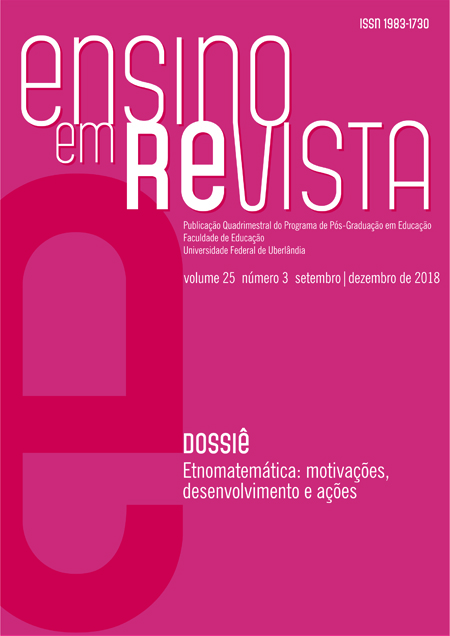Descolonizando a Etnomatemática
Conteúdo do artigo principal
Resumo
Etnomatemática surgiu como um projeto de descolonização. No entanto, questionamos se ela está cumprindo sua missão, uma vez que não apenas tem idéias intrínsecas contraditórias, mas também suas discussões filosóficas iniciais foram substituídas por receitas para pesquisa e prática em sala de aula baseadas em definições e métodos acríticos e superficiais. Neste artigo, pretendemos contribuir para recuperar o impulso descolonizador da etnomatemática. Depois de analisar a proposta teórica original de D'Ambrosio e o método de Gerdes com base nessa teoria, desconstruímos os princípios da matemática escolar como sua padronização platônica, abstrata, epistemológica e características argumentativas, bem como a teoria antropológica funcionalista na qual a etnomatemática é frequentemente formulada. Finalmente, oferecemos uma perspectiva alternativa baseada em filosofias e epistemologias indígenas que contribuem para a descolonização da etnomatemática.
Detalhes do artigo
Seção
Os trabalhos publicados são de propriedade dos seus autores, que poderão dispor deles para posteriores publicações, sempre fazendo constar a edição original (título original, Ensino em Re-Vista, volume, nº, páginas). Todos os artigos desta revista são de inteira responsabilidade de seus autores, não cabendo qualquer responsabilidade legal sobre seu conteúdo à Revista ou à EDUFU.
Como Citar
Referências
ALDER, K. A revolution to measure: the political economy of the metric system in France. In: NORTON WISE, M. (Ed.) The values of precision exactitude. Princeton: Princeton U. Press.1995.
ASCHER M. and U. D’AMBROSIO. Ethonmatehematics, a dialogue.Mathematics Education. v.14, n.2, pp. 36-43, June. 1994.
ASCHER, M. and R. ASCHER. Ethnomathematics. In: POWELL A. and M. FRANKENSTEIN, (Ed.) Ethnomathematics. Challenging eurocentrism in mathematics education.NY: SUNY Press. 1997.
BELAUNDE, L.E. Diseños materials e inmateriales:la patrimonialización del kené shipibo-conibo y de la ayahuasca en el Perú. Mundo Amazónico. V.3, pp. 123-146. 2012.
BENJAMIN, W. The origin of German tragic drama. 1.ed. London: Verso. 1998.
BISHOP, A. Removing cultural barriers to numeracy.In: Plenary address to 1992 National Conference of Australian Council for Adult Literacy, University of Sydney, October, 1992.
_____. Influences from society. In: BISHOP, A., HART, K., LERMAN, S. and T. NUNES.Significant influences of children’s learning of mathematics.Paris: UNESCO. 1993.
_____. Mathematical acculturation, cultural conflicts, and transition. In: DE ABREU, G. BISHOP, A., & N. PRESMEG (Eds.).Transitions between contexts of mathematical practices. Dordrecht: Kluwer. 2002.
CRUMP, T. The anthropology of numbers.1.ed. Cambridge, Cambridge U. Press, 1990.
D’AMBROSIO, U. Ethnomathematics and Its Place in the History and Pedagogy of Mathematics.For the Learning of Mathematics, v. 5, n. 1, pp. 44-48, Feb. 1985.
_____. Las bases conceptuales del Programa Etnomatemática.In:Revista Latinoamericana de Etnomatemática, v.7, n.2, pp. 100-107, 2014.
DASTON, L. Marvelous facts and miraculous evidence in early modern Europe. In: CHANDLER, J., DAVIDSON, A. and H. HAROOTUNIAN (Ed.) Questions of evidence. Chicago: U. of Chicago Press, 1991.
DESCOLA, P. Las cosmologías indígenas de la Amazonía. In: SURRALLES A. and P. GARCIA. (Ed.) Tierra Adentro. Lima: IWGIA. 2004.
EGLASH, R., BENNETT A., O’DONNELL, C., JENNINGS, S. and N. CINTORINO. Culturally situated design tools:Ethnocomputing from field site to classroom. American anthropologist, v.108, n.2, pp. 347–362, 2006.
_____ and FOSTER, E.On the politics of generative justice: African traditions and maker communities. In: MAVHUNGA C. (Ed.) What do sciences, technology, and innovation mean for Africa?Cambridge, MA: MIT Press. 2017.
FERREIRA, M. When 1+1≠ 2:Making Mathematics in Central Brazil. American Ethnologist. v. 24, n.1, pp. 132-147, Feb, 1997.
GAIA, C.A.; MOURA SILVA, M.G.;S. P., L. Ensino de matemática na educação do campo a partir de narrativas. In: Revista Latinoamericana de Etnomatemática,(10) 1.
GAVARRETE, M. and V. ALBANESE. Etnomatemáticas de signos culturales y su incidencia en la formación de maestros. In: Revista Latinoamericana de Etnomatemática, v. 8, n.2, pp. 299-315, 2015.
GERDES, P. On culture, geometrical thinking and mathematics education. In: POWELL A. and M. FRANKENSTEIN (Ed.) Ethnomathematics.Challenging eurocentrism in mathematics education. NY: SUNY Press. 1997a.
_____. Survey of current work in ethnomathematics. In: POWELL A. and M. FRANKENSTEIN (Ed.) Ethnomathematics.Challenging eurocentrism in mathematics education. NY: SUNY Press. 1997b.
_____.Geometría y cestería de los Bora en la Amazonía peruana. 1.ed Lima: MINEDU 2007.
GORGORIÓ, N. and N. PLANAS.Social representations as mediators of mathematics learning in multiethnic classrooms. European journal of Psychology of Education. v.20, n.1, pp. 91-104. 2005.
HOTTINGER, S. Inventing the mathematician:gender, race, and our cultural understanding of mathematics. Albany: SUNY. 2016.
LATOUR, B. Science in action.1.ed. Cambridge, MA: Harvard U. Press, 1987.
LAVE, J. Cognition in practice. Cambridge: Cambridge U. Press. 1988.
_____ and E. Wenger. Situated learning.1.ed. Cambridge: Cambridge U. Press. 199.
_____. Apprenticeship in critical ethnographic practice.Chicago: U. of Chicago Press, NY. 2011.
LIPKA, J., & ADAMS, B. (2007). Some evidence forethnomathematics: Quantitative and qualitative data from Alaska. In:F. Favilli (Ed.), Ethnomathematics and mathematics education:Proceedings of the 10th International Congress of Mathematics Education. Pisa, Italy: Tipografia Editrice Pisana.
LÚCIO, C.AND C. SABBA. As atividades culturais e a sala de aula no grupo étnico Herero/Helelo do sul de Angola (subgrupo Mucubal e Muhimba).In:Revista Latinoamericana de Etnomatemática,v.8, n.2, pp. 271-298, 2015.
MARTÍNEZ PADRÓN, O. AND M. OLIVERAS. Surcando caminos de interculturalidad sustentados en la Etnomatemática. In: Revista Latinoamericana de Etnomatemática, v.8, n.2, pp.341-363, 2015.
MIMICA, J. Intimations of infinity. 1.ed. Osford: Berg, 1988.
OGLE, V. The global transformation of time. Cambridge, MA: Harvard U. Press, 2015.
ROSA, M., D’AMBROSIO, U. CLARK, O. SHIRLEY, L. ALANGUI W. PALHARES P. GAVARRETE M.E. 2016. 1.ed. Current and future perspective of ethnomathematics as a program. ICME 13, Springer. Available in http://www.springer.com/us/book/9783319301198. Accessed in 11/7/17.
ROSALDO, R. Culture and truth.1.ed. Boston: Beacon Press, 1989.
URTON, G. The social life of numbers. 1.ed. Austin: U. of Texas Press, 1997.
WALKERDINE, V. Difference, cognition and mathematics education. In: POWELL A. and M. FRANKENSTEIN (Ed.).Ethnomathematics. Challenging eurocentrism in mathematics education. NY: SUNY Press. 1997.
WENGER E. Communities of Practice. Cambridge:Cambridge University Press, 1998.
WITTKOWER, R. Allegory and the migration of symbols. 1. Ed. London: Thames and Hudson, 1977.

